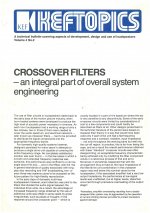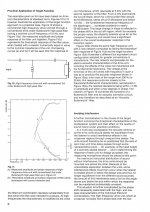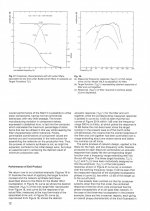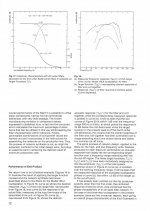Theoretically flat response on axis for odd orders, a 3.010... dB bump for even orders.Butterworth in theory gives you flat power as well as flat response.
And everyone writes that you can't cakculate the XO anyway and have to adjust the components, since a drivers is not a pure resistor but an impedance that depends on the frequency.
It's gone out of fashion now with all the optimizer computer programs, but the old-fashioned approach is to straighten the impedances in the frequency range around the cross-over frequency by putting an RC series network across the woofer and an LRC series network across the tweeter, use drivers that work up to at least an octave beyond the cross-over frequency and keep your fingers crossed.
That's a good approach but may have gone out of favor now that we can use optimizer programs to find a curve, no matter the the impedance or response. I know that I like to work that way - and use fewer parts. But sometimes it's still easier to flatten things first.
XOs are definitely not my forte, but my 'burning ' question is when did folks quit ~ automatically using a reactance annulled zobel before going further when wanting something close to textbook/whatever predictions?
Must be since V-cad then as I don't recall many using the early modelers or doing much measuring required for that matter.
Oh well, still believe (newbie) folks doing it the 'old way' should be made aware of/do it as it saves a lot of experimentation IME.
Oh well, still believe (newbie) folks doing it the 'old way' should be made aware of/do it as it saves a lot of experimentation IME.
I never thought of Butterworth or LR or whatever in acoustic terms. There is soooo much more going on in acoustics that I think it makes no sense to think of theoretical textbook filter functions when it comes to acoustic output.
Hmm, the pioneers taught me that XOs were for acoustic, electrical power division, otherwise, acoustic solutions to acoustic problems.
I have no experience with these modern cross-overs, but I guess it may be useful to know about Butterworth and Linkwitz-Riley filter's properties even if you want to use some fantasy filter:
Even-order Butterworth: woofer and tweeter signals in phase and at -3.01... dB around the cross-over point, power response integrated over all directions OK, bump in the on-axis response, main lobe not tilted
Odd-order Butterworth: 90 degrees phase difference, woofer and tweeter at -3.01... dB at the cross-over frequency, power response OK, on-axis response OK but more sensitive to driver phase response, main lobe tilted
Linkwitz-Riley: in phase, drivers at -6.02... dB at the cross-over frequency, on-axis response OK, main lobe not tilted, power response integrated over all directions has a dip
If you have some phantasy filter whose magnitude and phase responses around cross-over including driver response are similar to one of the theoretical filters, it is bound to have the same advantages and disadvantages as the theoretical filter. If it is somewhere in between, its advantages and disadvantages will also be in between.
Even-order Butterworth: woofer and tweeter signals in phase and at -3.01... dB around the cross-over point, power response integrated over all directions OK, bump in the on-axis response, main lobe not tilted
Odd-order Butterworth: 90 degrees phase difference, woofer and tweeter at -3.01... dB at the cross-over frequency, power response OK, on-axis response OK but more sensitive to driver phase response, main lobe tilted
Linkwitz-Riley: in phase, drivers at -6.02... dB at the cross-over frequency, on-axis response OK, main lobe not tilted, power response integrated over all directions has a dip
If you have some phantasy filter whose magnitude and phase responses around cross-over including driver response are similar to one of the theoretical filters, it is bound to have the same advantages and disadvantages as the theoretical filter. If it is somewhere in between, its advantages and disadvantages will also be in between.
One more point to add to the many other points already described is the issue of Baffle Step Compensation (BSC) which is often accomplished in the low pass filter section of the Xover.I am glad there are so many wise minds in this forum who have responded to my question. I can see that my question is not quite easy. Much of what you are saying is at a higher level than what I currently understand and there is also disagreement, I can see. In Danish you would say "I'm confused on a higher level" I don't know if that saying goes in English.
I had some thoughts ambut changing my tweeter Scanspeak D2905/970000 with a D3004/ 662000. But I wanted to understand my XO first, soI don't have to redesign the whole thing. I did not design my XO myself. It is from 1998, but I think it was made by a master in the field. When I read the thing about Q value, which I have not yet found out how XO affects it, I became curious since most XOs still deviate from the pure BUT and pure LR and you might end up somewhere in the middle in between, what is Q. I don't know the XO frequency and I am aware that you can't just calculate it from the 2 components 8.2 µF and 0.22 mH as it depends on how the unit measures before the XO comes on.
Now I have actually just tried to enter the values into a calculator program and there the 2 values will fit quite nicely on a Chebychev with a Q of 1, and according to what I read, it should give a terrible sound with many peaks and a lot of ringing. It is not characteristic of the speaker at all.
Many HiFi manufacturers of loudspeakers do not use separate components to accomplish BSC, instead they adjust the values of the components used for the low pass filter section of the Xover.
With this in mind, if you were to simulate the low pass filter section using the component values as you described above, you may get very confusing results because BSC would be included with the Xover response.
Regards.
Peter
Hi. What do you recommend for sb34nrx75-6 and aiyama 4 inch full range. ( F.a.s.t) Butterworth or LR? Active xo or 4 channel causes many cables crowd and gnd loops. Regards
- Home
- Loudspeakers
- Multi-Way
- Is it Butterworth or LR or does it matter



